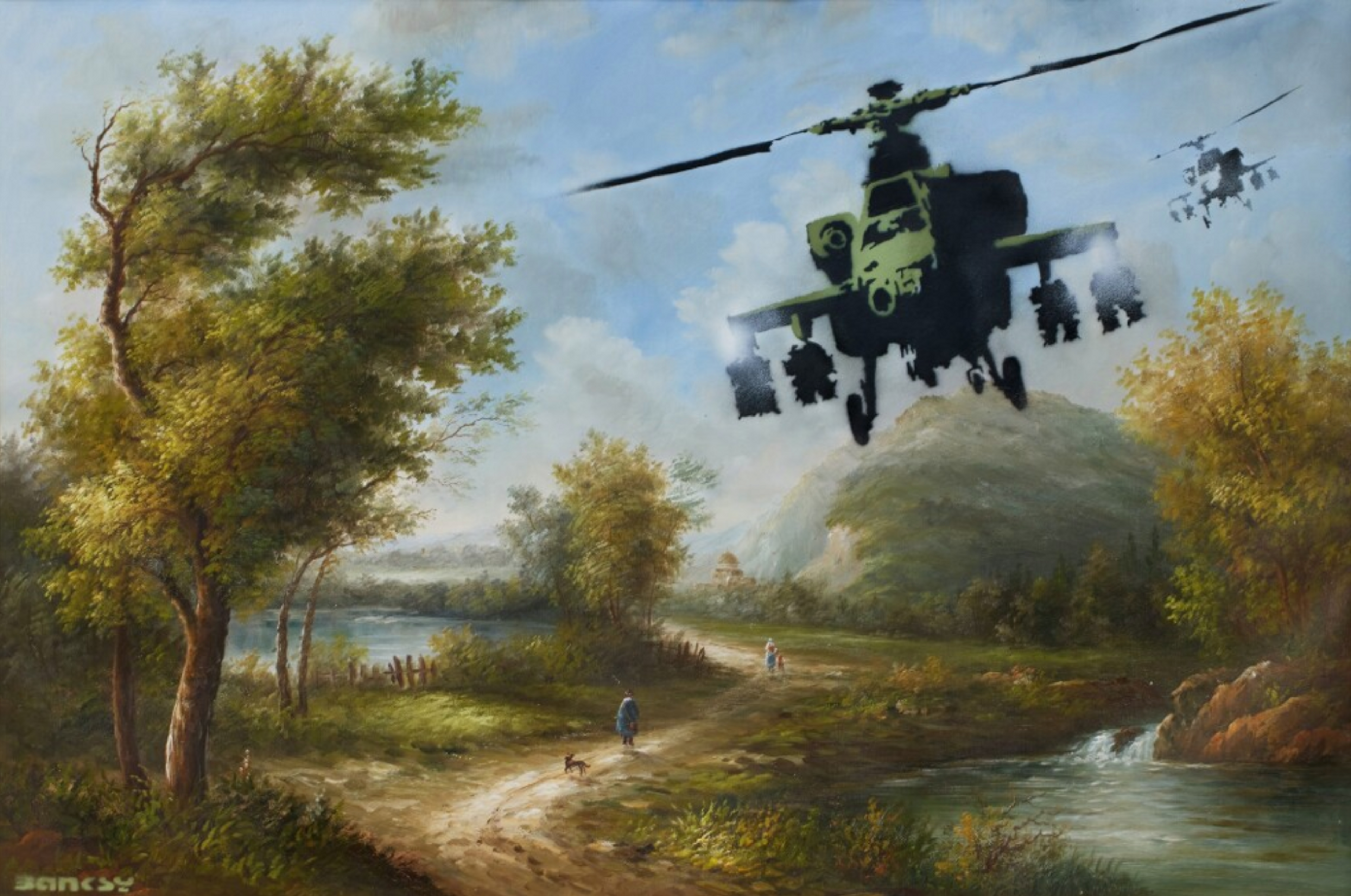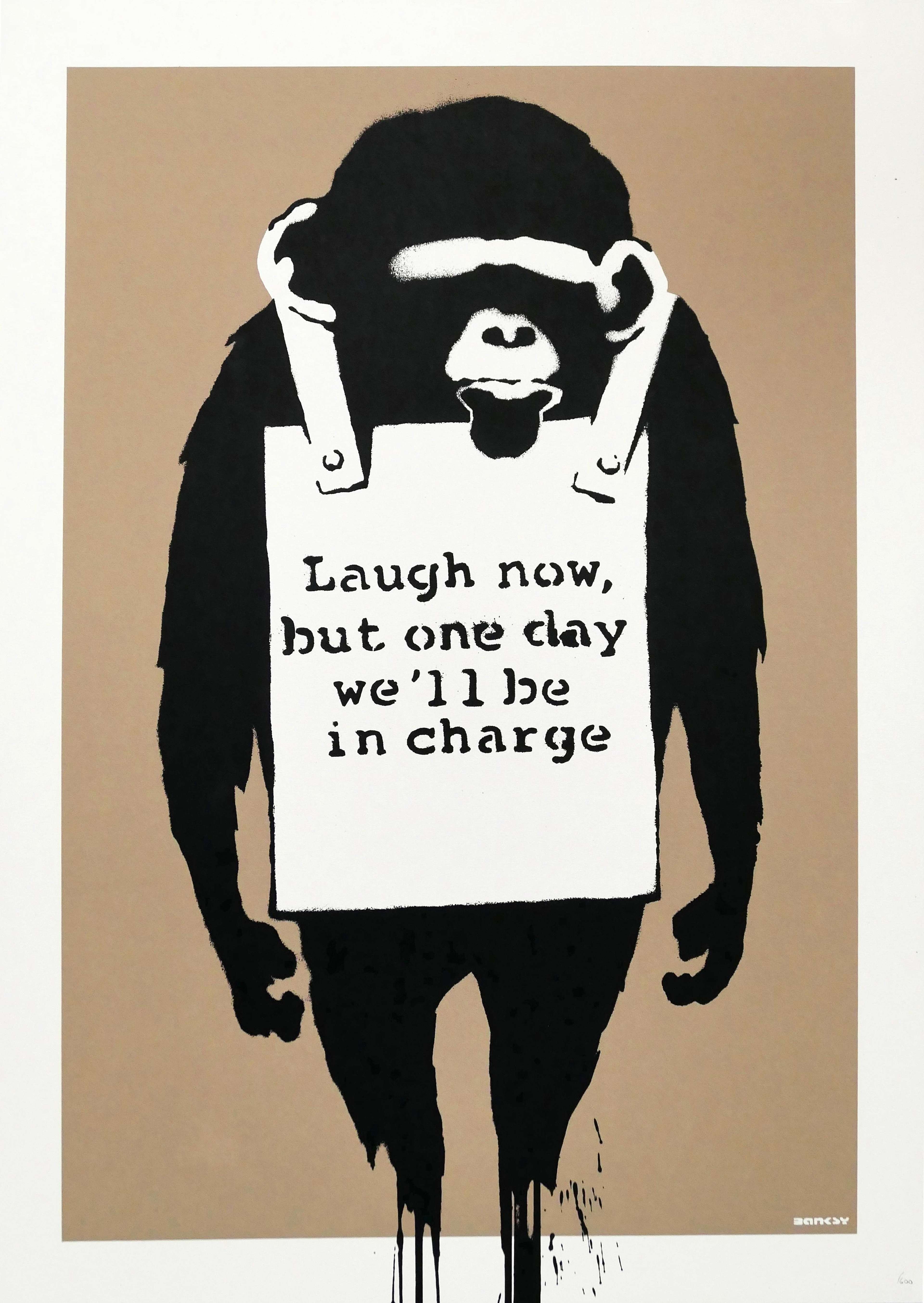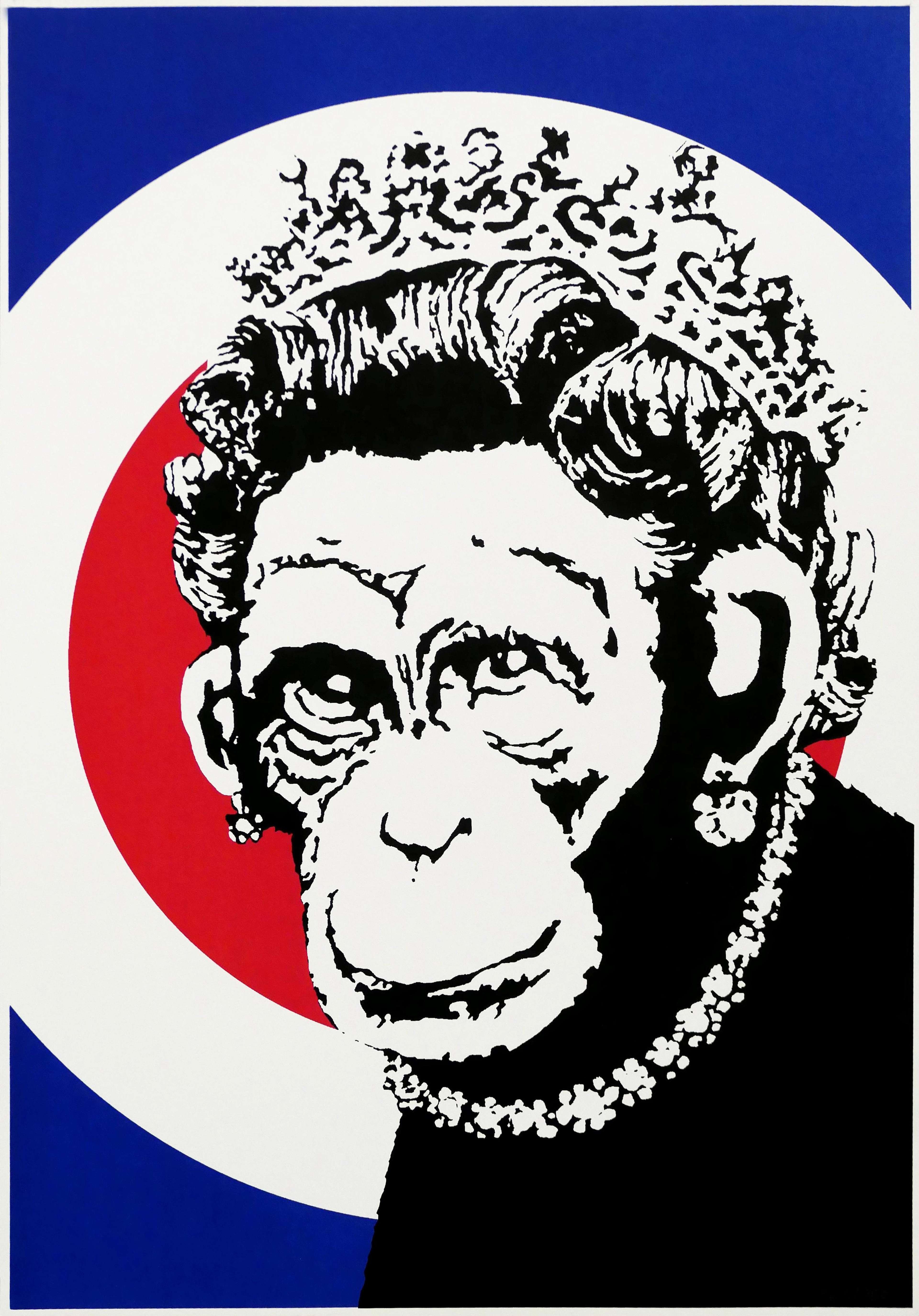 Self Portrait © Banksy 2000
Self Portrait © Banksy 2000
Banksy
269 works
Banksy monkeys have become an instantly recognisable motif in the graffiti writer’s oeuvre.
From Laugh Now to Banksy monkeys in parliament, the recurring motif has served as a rhetorical device, allowing Banksy to carry out activism and make astute political commentary.
The Bristol-born Street Art legend is well-known for his anarchic and satirical interventions in public space. Banksy has incorporated several recurrent motifs into his enormous and thematically diverse œuvre.
Why Monkey Artwork?
On the one hand, their small size mean that monkeys are easily reproducible on the street. Simple to paint quickly, the humble ape has allowed Banksy to avoid detection and worse – arrest by the police.
Secondly, and more importantly, however: monkeys are the perfect way for Banksy to communicate his scathing satires of humanity, and the diverse social and political mores for which he sees it directly responsible.
Here we unpack the meaning of some of Banksy’s most famous monkey-based artworks.
Banksy’s Monkeys, Brick Lane (2024)
Banksy’s latest urban masterpiece landed on Brick Lane, Tower Hamlets, on 7th August 2024, as part of his enigmatic return to London. This striking mural features three monkeys swinging across a rail bridge, adding a dynamic and playful touch to the cityscape. While monkeys are a recurring motif in Banksy’s oeuvre, these figures stand out for their departure from the familiar chimpanzees that typically populate his work. The trio has sparked speculation, with many interpreting their grouping as a nod to the age-old proverb: "See no evil, hear no evil, speak no evil." However, Banksy, true to form, has left fans guessing, providing no confirmation or commentary on the meaning behind the piece.
This mural is part of a larger series of animal-themed artworks that were unveiled daily on Banksy’s Instagram, beginning on 5th August. Each work has been strategically placed across London, forming an unpredictable trail from Richmond in the west to Peckham in the southeast. The series has inspired a flurry of interpretations, though the reasoning behind the specific animals and locations remains an enigma.
Monkeys hold a special place in Banksy’s artistic lexicon, often serving as stand-ins for humans to deliver biting social and political commentary. From a chimp-faced monarch for the Queen’s Golden Jubilee to his iconic use of a monkey mask in public appearances and pop-culture parodies, the primates embody themes of power, absurdity, and rebellion. In Brick Lane, these three swinging figures add yet another layer to the artist’s enduring critique of society.
Banksy Devolved Parliament (2009)
Banksy’s Devolved Parliament is an oil-on-canvas painting from 2009, depicting the Chamber of the House of Commons – one of the two chambers that make up the UK Parliament.
The main ‘difference’ between the painting’s portrayal and reality? The chamber is occupied not by MPs but by primates.
The work sold for an outstanding £9.9 million in 2019, becoming Banksy’s most expensive work at that time. The following year, in 2020, Devolved Parliament was quickly beaten to the title of record highest ever price for a Banksy artwork. Game Changer, a piece created on the one-year anniversary of the UK’s first coronavirus lockdown, sold for £16.8 million. All proceeds were gifted to NHS charities. Read more about Game Changer's sale in our article about it here. Subsequently, in 2021, Love Is In The Bin became both the only work of art ever to be created live at auction and Banksy’s all time highest selling piece, achieving almost £18.6 million at Sotheby's.
 image © Sotheby's / Devolved Parliament © Banksy 2009
image © Sotheby's / Devolved Parliament © Banksy 2009Laugh Now (2003)
As recent political events in the United Kingdom and beyond only confirm, Banksy’s iconic Laugh Now has proved somewhat prophetic.
A thinly veiled reference to the politicians who, for better or worse, run the country, this instantly recognisable piece features a monkey wearing a ‘sandwich board’. Displayed on it are the words ‘Laugh Now But One Day We’ll Be In Charge’.
Referencing Charles Darwin’s theory of evolution by natural selection, which proved that humans and monkeys share a common ancestor, Laugh Now is proof of Banksy’s sardonic wit and erudite treatment of contemporary culture.
Darwin’s face appeared alongside that of the late Diana Princess of Wales in the 2004 work, Di-Faced Tenners.
Monkey Detonator (2002)
An iconic work from the Banksy canon, his Monkey Detonator painting, sees the artist combine his tongue-in-cheek sensibilities with a dazzling proficiency for simple, captivating imagery and composition.
Accompanying a monkey – ready to plunge its arms downwards and spark an explosion – is a bunch of bananas. Strapped together with a timer, they are connected to the monkey via a simple line of yellow paint.
Like many other Banksy works, the Monkey Detonator painting has appeared in situ and was printed as an official print in 2002. In 2006, it appeared in a back alley in London’s Waterloo.
Monkey Poison (2004)
Melding classical and contemporary traditions, Monkey Poison (2004) sees Banksy stencil a gas guzzling monkey over the top of a Dutch Old Master reproduction. It is part of the artist’s Crude Oils series.
The striking contrast between the pointedly satirical primate and the bucolic, rural scene asks a difficult question: have we become mindless consumers of art unable to appreciate a work for its immaterial qualities? For how it makes us feel?
Monkey Poison isn’t the first time Banksy has confronted the capitalist logics of the contemporary art market. Many have interpreted the artist’s self-directed 2010 film Exit Through The Gift Shop as a complex publicity stunt designed to cast aspersions upon current market trends, which have seen art become a valuable material commodity.
Ironically, in 2020, Monkey Poison was sold by the owners of Amsterdam’s Moco Museum as a means to avoid sacking staff during the Covid-19 pandemic. It realised a staggering £1.5 million at auction.
 image © Phillips's / Monkey Poison © Banksy 2004
image © Phillips's / Monkey Poison © Banksy 2004Monkey Queen (2002)
Originally painted to mark the occasion of Queen Elizabeth II’s Golden Jubilee in 2002, Monkey Queen ‘takes aim’ at the reigning monarch. Likening the continued existence of the British Royal Family to a ‘primitive’ institution, this is one of Banksy’s more controversial pieces.
Depicting a monkey wearing the crown jewels, Monkey Queen has been composed in several variations.
In one version of the work, a monkey’s face is positioned against a gesturally painted Union Flag: a symbol of Britishness which, for many, has negative connotations.
This version once adorned the walls of The Chill Out Zone - a youth club in Newent, Gloucestershire, where it sparked complaints and a national scandal dubbed ‘Banksygate’.
Another version, which features the dartboard-like sphere used as a logo by ‘60s rock band The Who, satirises another key element of contemporary British culture – music – and its graphic, hard-edged iconography.
Simple Intelligence Testing (2000)
Simple Intelligence Testing is a 5-part canvas-based work that recounts the travails of a chimpanzee. Subjected to a behavioural experiment, the chimpanzee seeks out an edible reward, hidden in one of several green boxes.
In the painting’s final panel — and having found and eaten a banana — the chimpanzee arranges each of the three boxes on top of each other. In a final show of its intelligence, the chimpanzee then uses the boxes to escape through a ventilation shaft in the ceiling. Don’t underestimate the monkey, Banksy tells us.
An early Banksy work, Simple Intelligence Testing was exhibited in 2000 at Bristol’s Severnshed, in what was the artist’s first ever solo exhibition. In 2008, it sold for £635,000 at Sotheby’s auction house in London.
 image © Sotheby's / Simple Intelligence Testing © Banksy 2002
image © Sotheby's / Simple Intelligence Testing © Banksy 2002As we have seen, Banksy cleverly uses monkeys to make political points from all angles; they are not always a symbol of the political establishments slovenliness, as in Devolved Parliament, though that is often the final takeaway message. Monkeys are, in Banksy's artwork, at times an allegation of humanity as backwards, unevolved, and at times, a reminder of our proximity to those 'below' us on the ladder—whether that is in relation to class, or our actual treatment of animals.
Above all else, monkeys are an instantly recognisable signature of Banksy's oeuvre.








